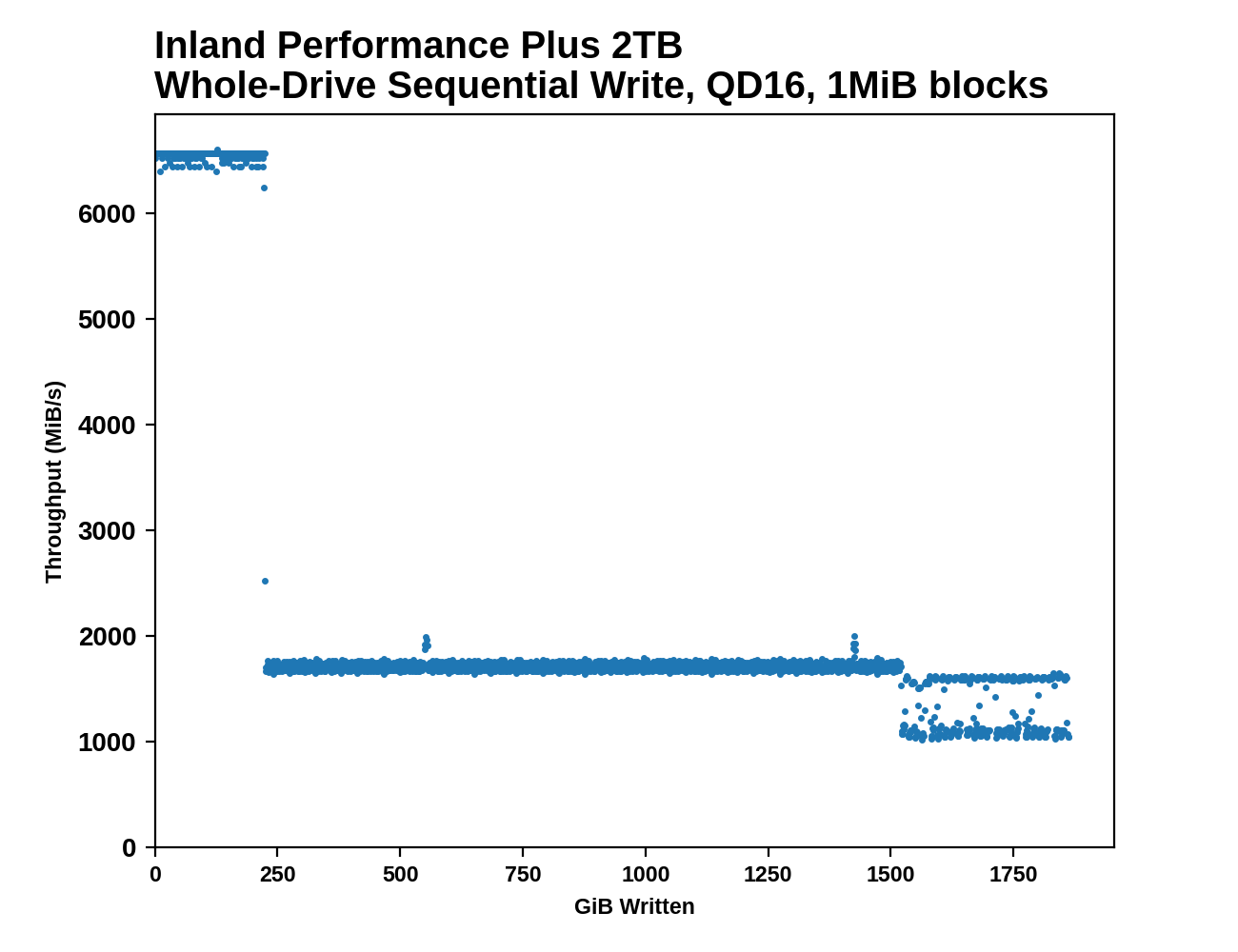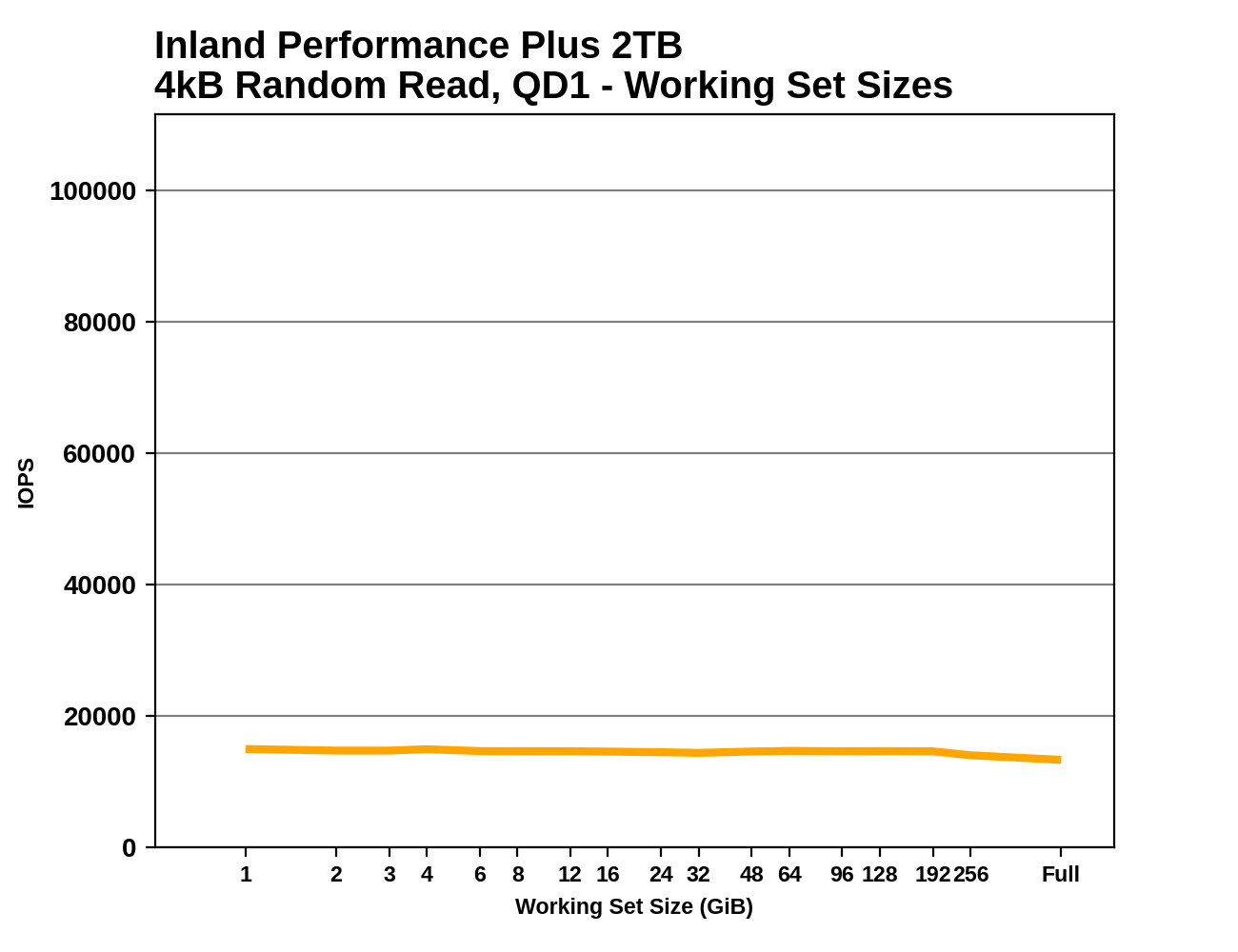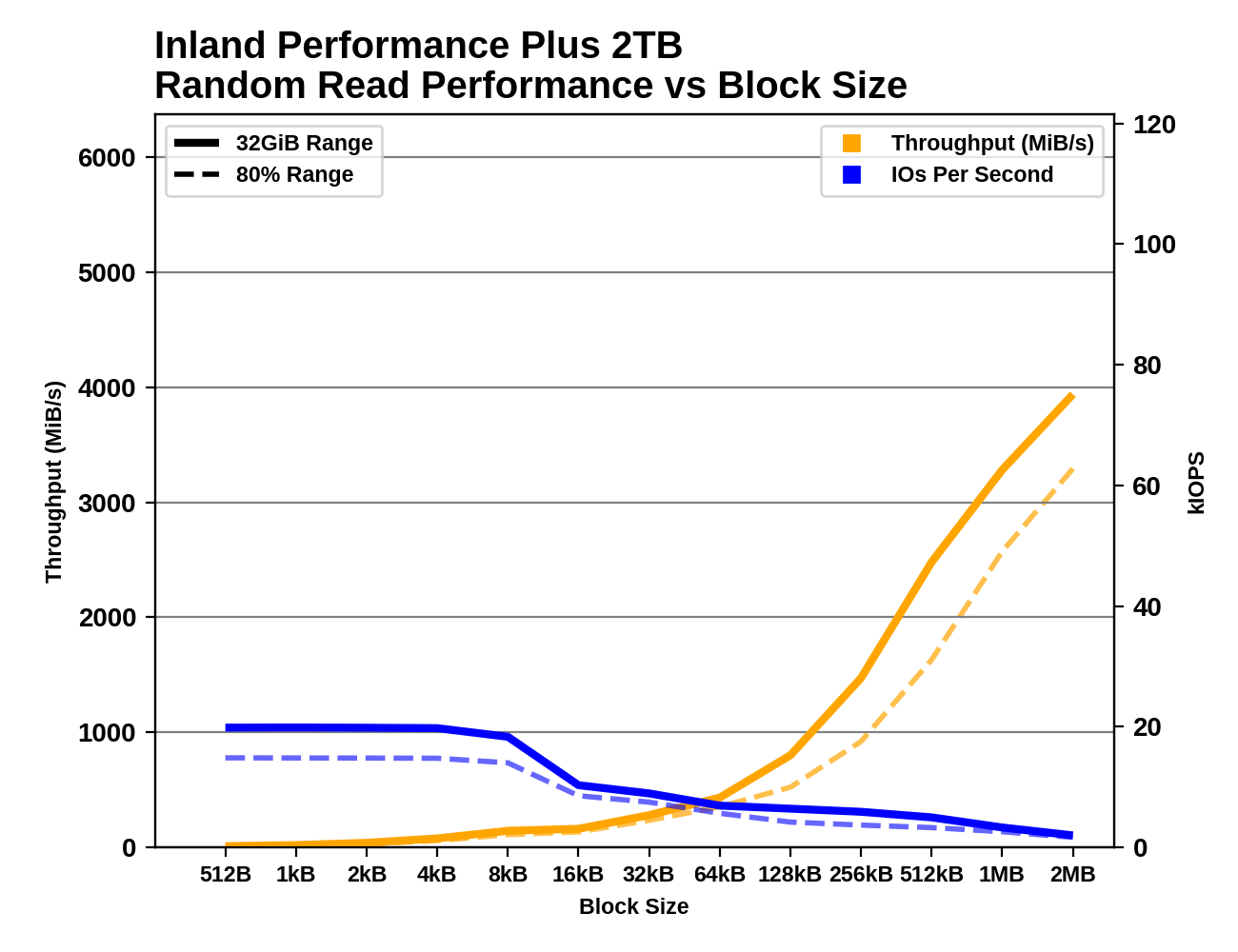The Inland Performance Plus 2TB SSD Review: Phison's E18 NVMe Controller Tested
by Billy Tallis on May 13, 2021 8:00 AM ESTAdvanced Synthetic Tests
Our benchmark suite includes a variety of tests that are less about replicating any real-world IO patterns, and more about exposing the inner workings of a drive with narrowly-focused tests. Many of these tests will show exaggerated differences between drives, and for the most part that should not be taken as a sign that one drive will be drastically faster for real-world usage. These tests are about satisfying curiosity, and are not good measures of overall drive performance. For more details, please see the overview of our 2021 Consumer SSD Benchmark Suite.
Whole-Drive Fill
 |
|||||||||
| Pass 1 | |||||||||
| Pass 2 | |||||||||
The SLC write cache on the 2TB Inland Performance Plus lasts for about 225GB on first pass (about the same cache size as 980 PRO, but a bit faster), and about 55GB on the second pass when the drive is already full. Performance during each phase of filling the drive is quite consistent, with the only significant variability showing up after the drive is 80% full. Sequential write performance during the SLC cache phase is higher than any other drive we've tested to date.
 |
|||||||||
| Average Throughput for last 16 GB | Overall Average Throughput | ||||||||
The post-cache performance is a bit slower than the fastest TLC drives, but overall average throughput is comparable to other top TLC drives. The Inland Performance Plus is still significantly slower than the MLC and Optane drives that didn't need a caching layer, but one or two more generational improvements in NAND performance may be enough to overcome that difference.
Working Set Size
 |
|||||||||
As expected from a high-end drive with a full-sized DRAM buffer, the random read latency from the Inland Performance Plus is nearly constant regardless of the working set size. There's a slight drop in performance when random reads are covering the entire range of the drive, but it's smaller than the drop we see from drives that skimp on DRAM.
Performance vs Block Size
 |
|||||||||
| Random Read | |||||||||
| Random Write | |||||||||
| Sequential Read | |||||||||
| Sequential Write | |||||||||
There are no big surprises from testing the Inland Performance Plus with varying block sizes. The Phison E18 controller has no problem handling block sizes smaller than 4kB. The random write results are a little rough especially when testing the drive at 80% full, but it's hardly the only drive to have SLC cache troubles here. Like many other drives, the sequential read performance doesn't scale smoothly with the larger block sizes, and the drive really needs a larger queue depth or very large block size to deliver great sequential read performance.










118 Comments
View All Comments
Spunjji - Friday, May 14, 2021 - link
Yes, that's why I said "most of us". I know there are use cases that benefit from them, but the majority of the time they don't apply to a majority of users.jabber - Friday, May 14, 2021 - link
Yeah you are correct, 'most users' do not notice and most don't need the speed but you will always get the one or two who, for some reason, choose to work with 8K video all day and think they are 'most users'.James5mith - Thursday, May 13, 2021 - link
Please add one of the new 5800x Optanes into the mix. I would like to see what Optane + PCIe4.0 can do as far as sustained performance.It's really sad that none of these drives can maintain performance except for the old 970 Pro and the Optane.
mode_13h - Thursday, May 13, 2021 - link
> Please add one of the new 5800x Optanes into the mix.It would be amusing to see a 4.3M IOPS drive compared to consumer SSDs. However, the pricing on those things is pretty nuts. If such performance is worthwhile for you, you already know you want one.
That said, I'm always interested in seeing cutting edge tech put to the test.
Tomatotech - Friday, May 14, 2021 - link
> maintain performanceAbsolutely not needed for the average price-sensitive user. It’s like buying a 40-ton truck instead of an average family car. And the average family car will outperform the truck in acceleration, top speed, fuel economy, and ease of storage / parking.
There’s many drives available for people who need 100% sustained performance or other industrial metrics and they’re going to cost a bit more.
DigitalFreak - Thursday, May 13, 2021 - link
I'm waiting on DirectStorage before I upgrade.mode_13h - Thursday, May 13, 2021 - link
Why?RSAUser - Friday, May 14, 2021 - link
Because there is no real-world gain for most people going from a normal PCIe 3 SSD to PCIe 4 SSD right now, they're within ms of each other.If DirectStorage starts taking off, it could maybe have a more noticeable impact in terms of texture loading, etc.
mode_13h - Saturday, May 15, 2021 - link
I guess it also depends on what you're upgrading from.It amazes me how some people complain that it's not worth upgrading a CPU (for example), when they have one from the preceding generation! I'm like: well, join the crowd! Most of us keep hardware for *multiple* generations.
So, I find it's also worth keeping in mind that people complaining that it's not worth upgrading might be bringing unrealistic expectations.
thestryker - Thursday, May 13, 2021 - link
I'm not sure the feasibility, but I'd be really curious to see how the PCIe 4 SSD performance varies between AMD and Intel. I know some of Intel's nebulous marketing materials had suggested RKL was better than the Ryzen alternatives, and while I highly doubt that I haven't seen any reviewers test out the same drive on both platforms.I'd also like to second that dream that you'll be able to run a P5800X through the test suite.